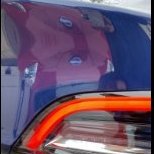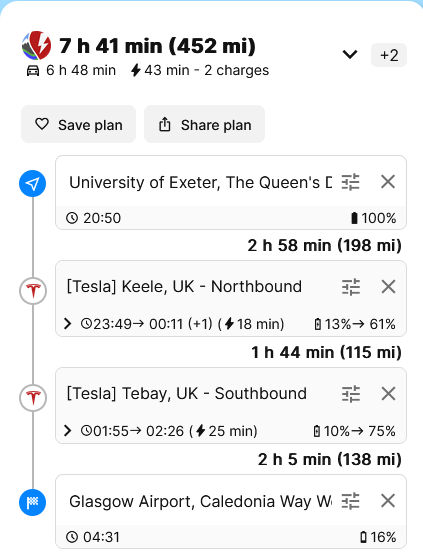-
Posts
2,263 -
Joined
-
Last visited
Content Type
Profiles
Forums
Gallery
Shop
Events
Downloads
Everything posted by wyx087
-
Wow, 600 kW regen. This one is funny: https://www.independent.co.uk/tech/electric-car-vehicle-range-anxiety-b2535524.html snippets: No sh** Sherlock! I've been saying this for years.
-
Windows 10 and 11 updates have been problem and stress free for me for many years. It updates when I shutdown or overnight, zero problems. Same with my MY, it notifies me via the app that update is available and plans to install overnight. I have the option to not install or install immediately. Update takes ~30min to install, I usually set it to install when I know I don't need the car for the next hour. I've read a story on Reddit someone had wrong drivetrain software applied (error about wrong drivetrain, won't drive), sorted within 2 hour of raising the issue with Tesla, via another OTA update. Other than that, I've not heard or experienced any issue with the update. The reason there's excitement with Tesla updates because it's seamless and actually add meaningful features. Upcoming update is an UI update to bring it in line with the triangle truck: https://www.notateslaapp.com/news/1988/inside-teslas-new-v12-user-interface A feature wasn't sold and advertised was added over 1.5 year after I got the car: matrix headlights: https://www.notateslaapp.com/news/1902/tesla-to-add-support-for-matrix-headlights-for-existing-vehicles-in-upcoming-software-update One of those safety improvements: https://www.notateslaapp.com/software-updates/upcoming-features/id/1644/tesla-updates-hazard-lights-frequency-to-improve-safety-in-software-update I believe other companies are doing similar, VW v3 software added lots of necessary EV features. On top of all that, the "Tesla vision" based adaptive cruise and lane centering (aka. Autopilot) function continues to improve. It used to go wide if a bend exceed max EU allowable steering angle. Then there was a period it would harshly brake when going wide to bring itself back in. Now it slows down at the bend, able to navigate some without intervention and staying within regulation. It used do phantom braking every time going under a particular bridge on a dual carriage way, I've not had any unexplainable phantom braking for many months. All that is on v11. Americans are getting full AI, zero hand written code v12 and reports say "full self driving" upgrade feature drives almost human-like.
-
For Tesla: https://www.tesla.com/en_gb/support/connectivity No ongoing cost for standard connectivity for first 8 years, this is basic map and live traffic based nav routing. (currently free for everyone) Premium connectivity, benefits see link, is £10 per month. I plan to buy it for 1 month for my road trip to Skye. Software and map OTA updates are downloaded whilst connected to Wi-Fi. Most premium features usable via Wifi (including via phone hotspot) Without any connectivity, cars are still drivable, will also receive software and map updates via Wi-Fi, and bluetooth phone key will still work. Reading the link. It seems I made the cut for lifetime free standard connectivity. For Nissan, as we've seen previously, support ended for 2016 and earlier cars with "CarWings" 😡. 2016-2020 have free connectivity similar to CarWings, ends whenever Nissan decides it's no longer worth it. 2020 or later cars have a subscription cost after first 3 years for different optional service packages (remote control, map update, live traffic) https://www.speakev.com/threads/nissan-connect-pricing-post-free-3-year-complimentary-period.175585/
-
When I put down my deposit, they only had LR available. They then raised LR price, was during mad chip shortage mid 2022. A few week before collection, they made SR available. SR was £2000 cheaper than my order while LR was £4000 more expensive. In all honesty, SR would have been more than enough for my needs. I've only ever used full range (100% down to 8%) once on a day trip, having a short top-up break wouldn't have changed anything. There's DC rapid charger everywhere down south. My point is, UK is not exactly a big island. Civilisation is everywhere. It's not like people on this island regularly drive 1000+ miles American road trip, or really need that 600+ miles range because they are in the Australia outback. Especially up to Manchester, trunk roads DC rapid charging infrastructure has now been built up at incredible speed. City EV or LR EV doesn't matter, all can do long distance drive. Difference is a few more stops for car isn't designed for it. A few more comfort breaks for less suitable cars wouldn't hurt. Just as people driving CityGo wouldn't drive 200+ miles daily commute.
-
Nice of you to put words in other people's mouth. All I'm doing is educating, especially on complex topics. For example, believing Google's 11 kW charge rate, or a random summary article about solar FIT. In your instance, Google isn't wrong, the max on-board AC-DC charger is 11 KW. But DC charging rate can be faster. Able to do multiply and division does not mean able to calculate a complex system..... If you want to use rule of thumb by lowering average travel speed from 70 mph down to 50 mph. It makes EV driving much more feasible because as speed decreases, time between charging increases beyond human capability. Let's do an proper comparable example with the Mini. https://abetterrouteplanner.com/?plan_uuid=2f36d593-2cfb-4f2c-a41a-74ba84eb5d5f 6 hr 50min driving; 2 hr 45min charging. Compared to using MY LR: 6 hr 48min driving; 43min charging. City EV can do long distance, just like early Nissan Leaf have been driven JoG to LE. City EV's need more stops to top up, roughly every hour for the Mini it seems. There's so many charging hubs along trunk road these days it's really non issue. Newer ICE cars are different and don't connect to the internet?
-
Great to see you finally get why EV's are so convenient in day-to-day use. Unfortunately you've started dribbling nonsense here when you tried to calculate EV long distance travel times using a 11 kW charger. First, I'd love to see anyone driving a diesel car for 9.25 hours "almost non stop". Does diesel driver run to the toilet so that they stop less than 5min? Or does this come as standard? 😛 Second, remember EV's are capable of 200+ kW charging speed. ~20min top up while you stretch and eat. This is a typical long drive, a pit stop every ~2 hour for ~20min. Wouldn't be much longer than driving a diesel and also doing comfort stops. Ah okay. Sorry. I got confused by the word "latch". I thought that's the bit you are holding. Prey, do tell, why do UK not have the locking pin whereas some other countries do have this locking pin? Why do you think it's okay to circumvent this restriction?
-
https://www.hse.gov.uk/pubns/indg216.htm Also:
-
Last time I refuelled, about 2 years ago, I don't remember UK allows petrol nozzles to lock. How do you walk around your car if you must hold the petrol nozzle?
-
UK is only 1100 odd miles furthest top to bottom. 5-6 ~30min stops is more than reasonable for 16 hour drive. Let's be honest, UK is a small island with roads that are getting clogged up by the day. I can imagine the same view of UK from mainland Europe/China/India/America/Australia. Why wouldn't population on this modest sized island drive EV's?
-
Indeed there's 2 elements to FIT payment: generation and export. But don't always assume what you read is 100% correct, because websites like those usually take shortcuts to describe a complex system. All people on FIT start off with deemed export because it predates smart meters, older non-smart meter cannot measure export. Deemed export means for each kWh generated, they deem 50% export regardless of how much is self-consumed. Meaning use as much as possible without consequence for people on FIT. For example, my statement for gloomy autumn/winter days. Effectively it's ~20p/kWh based on generation for me regardless of how much I use, since V2H install, I consistently self-consume over 95%. Then there's higher paying SEG (smart export guarantee). People on FIT can move the export part to SEG (one way) to get better rates such as 15p from Octopus, currently. FIT still pays generation part whereas newer installs only get paid SEG. But today's solar PV installs are much cheaper and generate more. So overall ROI is said to be similar. My neighbour also installed 10 panels, but got 4 kWp system (my is 2.9 kWp) installed for just £4000. Coming back to your view that there's associated cost, it's only true for newer installs as you rightly pointed out. But for FIT, it depends, usually it is completely free.
-
Ah yes, if not on EV tariff, self consuming net a saving of 5-15p currently, depend on tariffs. If charging without solar over night: 20p cost. But off-set by -15p solar export payment = 5p net cost for charging EV up to solar generation amount. If charging via solar divert method: -5p cost (net saving) because you wouldn't need to pay that 5p/kWh. So instead of my 7.5p saving for EV tariff + FIT solar. You are saving 5p/kWh using solar divert.
-
With public EV charge points double every dozen of months, people think sometime in 2025 we will see 1000 rapid charging hubs around UK. https://www.speakev.com/threads/when-will-we-see-1000-ev-rapid-charging-hubs-in-uk.184481/ According to this crowd sourced maps, we've already got over 500 rapid charging hubs (need 5 or more charger to count): https://www.google.com/maps/d/u/0/viewer?mid=1DOswN-GODssM2XmKV4oQ9r-mkGcbGno&ll=52.183213135981326%2C-0.863469044656453&z=8 The golden age of EV travelling might be upon us, with general public slowing down adoption whilst hub building is full steam ahead. I think this is the right way to do it, build it and they will come.
-
But if your import is 7.5p/kWh overnight on EV tariffs?
-
Let me explain again, FIT is based on generation. Self-consuming has no associated cost. If you want to deliberately base your understanding on snippets of truth, it's your choice. But you are completely wrong here with regard to FIT.
-
Without FIT (~2016 or earlier installs, based on generation), you'd be on SEG (smart export guarantee, based on your export). You should be getting 10-15p/kWh? It would make more financial sense to export as much as possible and charge up your battery/EV at as cheap rate as possible. Provided export pays more than cheapest import. For example, Intelligent Octopus Go is 7.5p/kWh import overnight and 15p/kWh SEG. So doesn't make financial sense to self consume because each kWh you self-consume is effectively 15p. Here are the best EV tariff and SEG tariff from different suppliers: https://www.speakev.com/threads/list-of-ev-tariff-for-2-5p-mile-motoring.179786/ Also got to remember unlike my V2H bi-dir charger, where it basically behaves like a home battery, you will need to generate consistently more than 1.4 kW in excess to charge EV using solar divert feature in "standard" EV charge points. That is due to charging standards. https://myenergi.info/minimum-charge-current-need-to-allow-user-to-set-t-t5646.html For my 2.9 kWp E-W install, EV charge point's solar divert feature doesn't make sense. I have this capability in my other "standard" charge point but it doesn't work due to low amount of excess. I managed to get around the 6 A limitation by using Tesla API, when Leaf isn't at home: https://www.speakev.com/threads/charging-off-excess-solar-using-dumb-charger-and-home-assistant.177813/#post-3441721
-
You are telling me this isn't charging for free from solar array? edit: for info: the line is battery charge level, the filled lines are solar generation and where it went. Cost of solar: £7000 about 9 years ago. Return on investment: about 10 years mark, accounting for inflation. Effective cost of solar from after ROI: free. Feed in tariff is based on generation, not export. So self-consumed as much as possible. Charge car or don't charge, it doesn't make any difference to the payment.
-
https://electrek.co/2024/04/19/kias-15000-ev2-caught-in-wild-most-affordable-ev-video/ Kia EV2, $15k BEV, spotted in the wild.
-
I'm surprised the Taycan hasn't burst into flames according to the stuff people say on the internet 🤪
-
But why are 240 kW capable Korean 800v cars not able to charge at full speed on 250 kW Tesla 400v chargers? Why are 250 kW capable Tesla cars not able to charge at full speed on 350 kW ultra-rapid? What about 400v AC, which EV onboard charge is able to charge from that? As usual, devil is in the detail. for rapid charger it is amp limited and car voltage dependent to deliver maximum power in kW. If only the public is willing to learn about this new tech, how different speed is individually useful in different situations. At very least learn how to best operate their own machines.
-
Then what's the point of the video? Highlight how not to charge EV's, but present it as a problem. Destination charging at hotels would solve all problem for tourists. Public infrastructure should always be the fallback. 7 kW charge points are never designed to get people from A to B, it is designed for people to use whilst parked up at B. For example, my 600 miles drive to Portree, I would not have to worry about charging. Tesla software takes care of everything, Tesla superchargers all the way. But around Isle of Skye, I'll need a top up charge. If I were able to charge at the B&B for just 1 night, I wouldn't have any worry for the duration of my stay on the isle. Scotland council installed rapid charger is the last resort fallback. I'll be travelling in May bank holiday as well as kids' half term. One of busiest week for tourists. I'm not at all worried about potential queueing.
-
Tesla is not known to book people in for anything software related, they prefer to solve remotely by pushing a new OTA update, failing that it's "ranger" to your door, service centre is last resort. So might needed a new charge port or onboard charger? Not sure what's the problem with Kia..... again, doesn't sound like software related. Sounds like dealer or Kia UK doesn't know what's wrong with the car.
-
Out of interest, what sort of problems? Is it Tesla/Apple's "my way or the highway" or something that is serious and makes the car undriveable?
-
Only if vehicle built-in self diagnostic cannot make sense of what went wrong. With simple machines, the error code should get you 90% there: https://www.tesla.com/ownersmanual/model3/en_us/GUID-9A3F0F72-71F4-433D-B68B-0A472A9359DF.html The customer can also check and self diagnose: https://teslatap.com/articles/service-mode/
-
Car parts assembly company and mechanical parts replacement technician don't have a handle on electronics, who would have thought! FWIW, all the OTA updates I've done on my Tesla were problem free. I've read story of Tesla not able to be driven due to wrong drivetrain software received via OTA update. It was sorted within 2 hours of phoning them up.
-
There are around 32 million cars on the road in 2017. https://www.statista.com/statistics/299972/average-age-of-cars-on-the-road-in-the-united-kingdom/ Let's say 100 thousand li-on cars by 2017, more than double from your data in 2015. That is just 0.31% out of total cars. More than 1000 cars were involved in the 2017 fire, let's say 1500. So statistically, there will only be 4 li-on equipped cars. How much damage could 4 small li-on battery contribute, in comparison to fuel in over 1000 fuel tanks? Are the building material and structure design similar between the Liverpool car park and Luton airport car park? Otherwise making this comparison is rather misleading.










